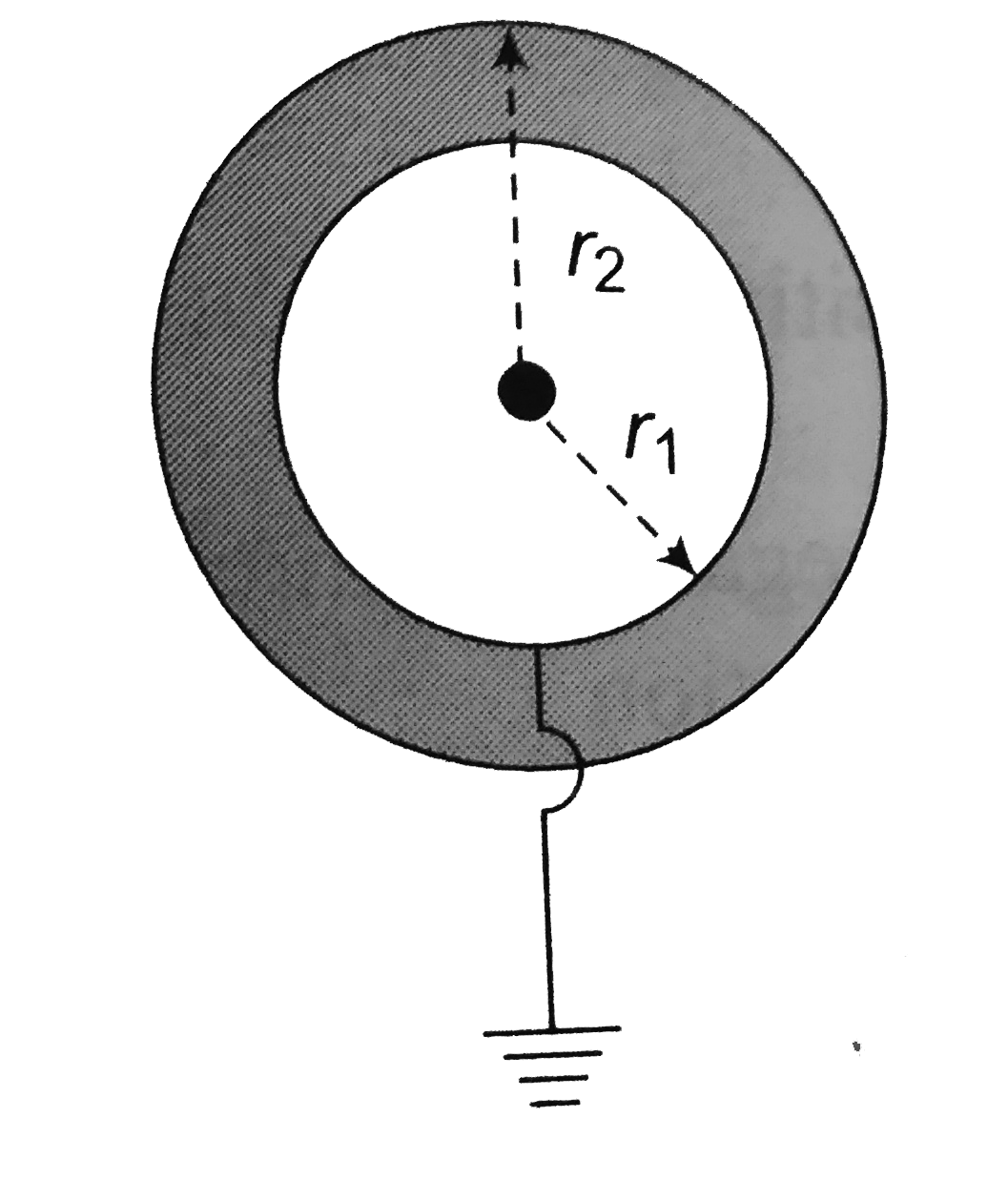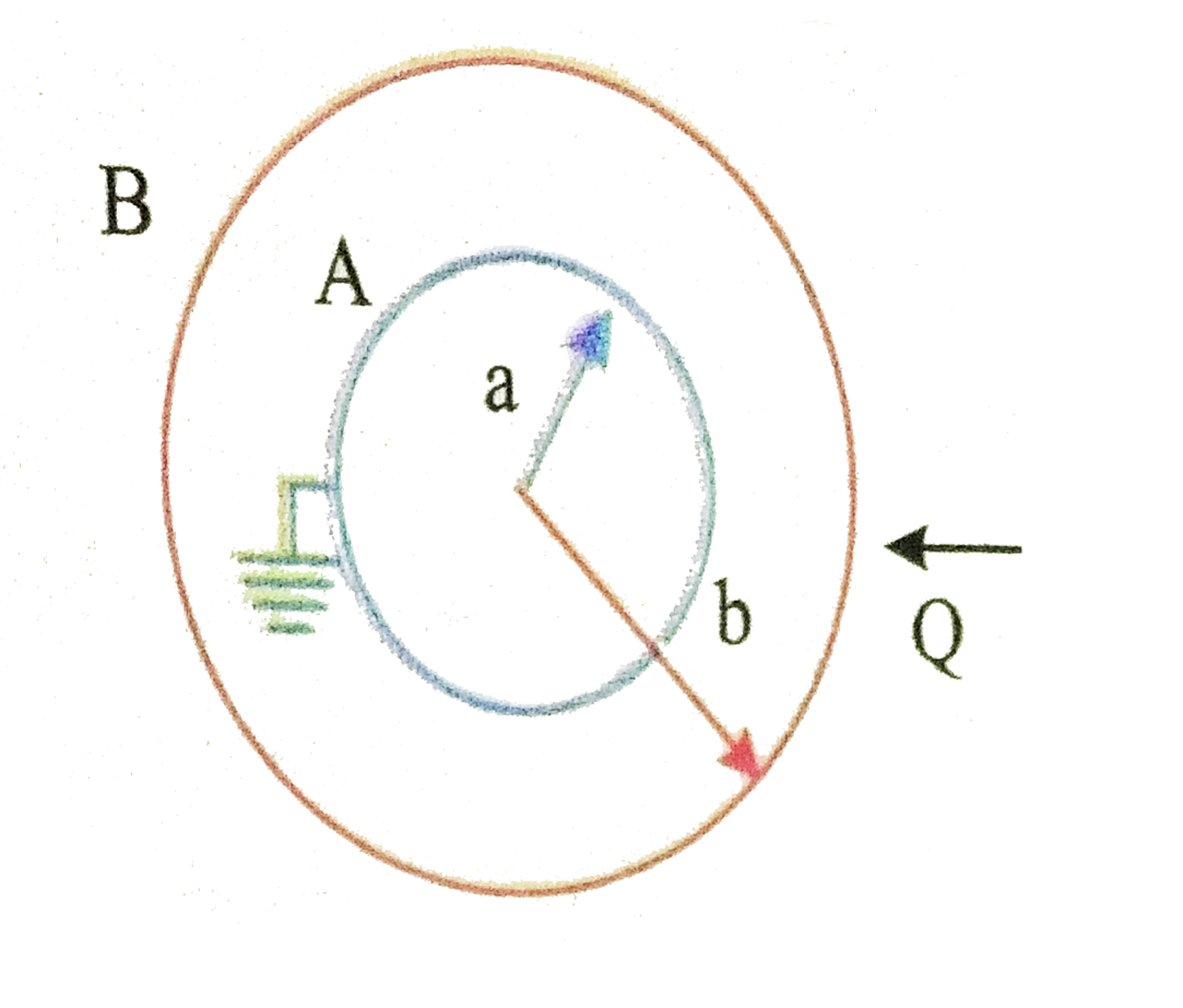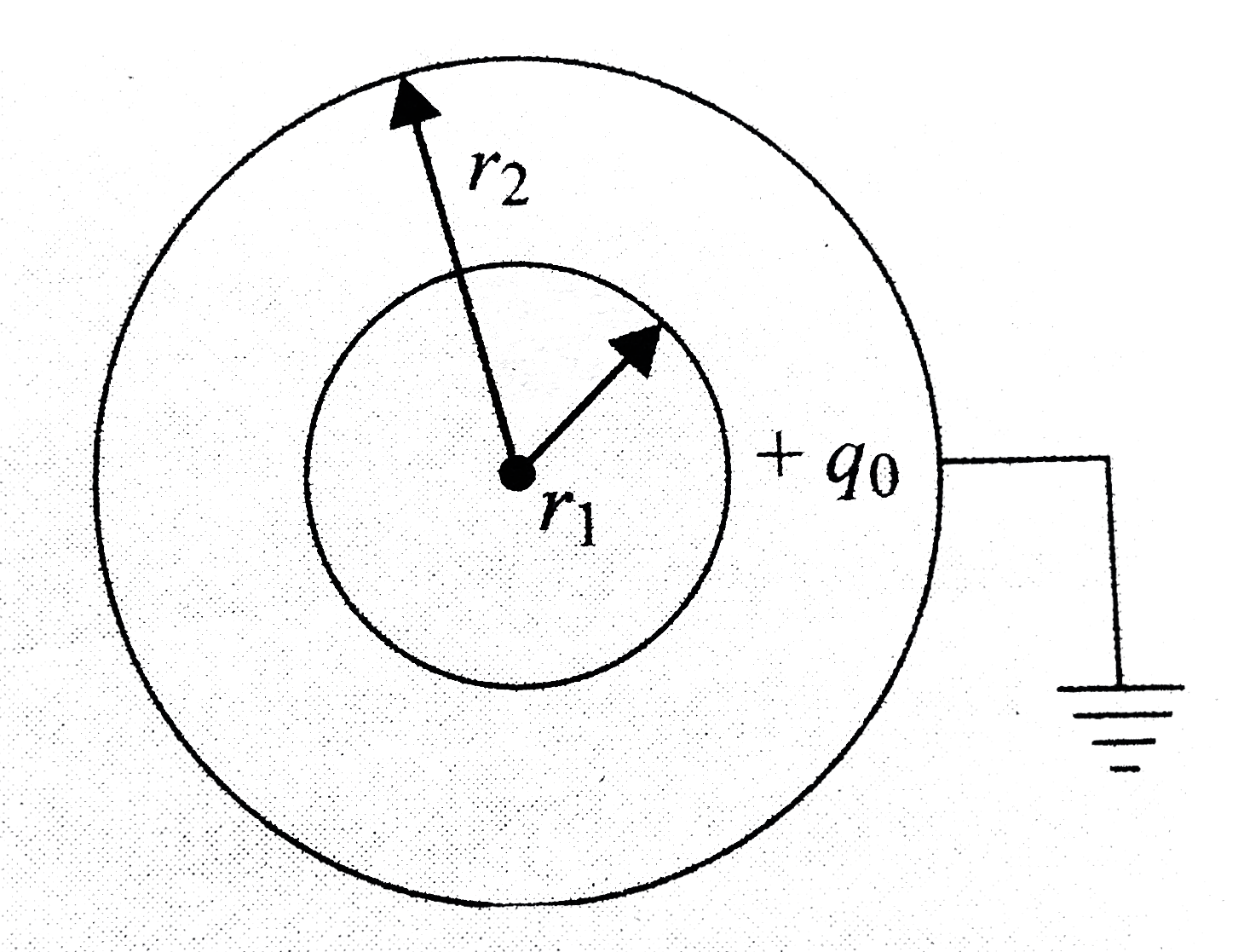There are two concentric metal shells of radii r1 and r2(>r1). If initially, the outer shell has a charge q and the inner shell is having zero charge and then inner shell is grounded. Find :
(i) Charge on the inner surface of outer shell.
(ii) Final charges on each sphere.
(iii) Charge flown through wire in the ground.
The correct Answer is:(i) (r1/r2)q
(ii) Charge on inner shell=−(r1/r2)q and charge on the outer shell =q
(iii) Charge flown in to the earth =(r1/r2)q
Let's solve the problem step by step.
Given:
- Two concentric metal shells with radii r1 (inner shell) and r2 (outer shell, where r2>r1).
- Initial charge on the outer shell = q.
- Initial charge on the inner shell = 0.
- The inner shell is grounded.
(i) Charge on the inner surface of the outer shell
1. Understanding the grounding of the inner shell:
When the inner shell is grounded, it can exchange charge with the earth until its potential becomes zero.
2. Let the charge that flows to the inner shell be Q. Since the inner shell is grounded, its potential VA must be zero. The potential at the inner shell due to its own charge and the charge on the outer shell can be expressed as:
VA=k⋅Qr1+k⋅qr2=0
where k is Coulomb's constant.
3. Rearranging the equation:
k⋅Qr1=−k⋅qr2
Q=−r1r2⋅q
4. Charge on the inner surface of the outer shell:
The inner surface of the outer shell will induce a charge equal in magnitude but opposite in sign to the charge on the inner shell:
Charge on inner surface of outer shell=−Q=r1r2⋅q
(ii) Final charges on each sphere
1. Final charge on the inner shell:
From the previous calculation, the final charge on the inner shell is:
Charge on inner shell=Q=−r1r2⋅q
2. Final charge on the outer shell:
The outer shell initially had charge q. The charge on the inner surface is −Q, and the outer surface will have:
Charge on outer shell outer surface=q+Q=q−r1r2⋅q=q(1−r1r2)
(iii) Charge flown through the wire in the ground
1. Initial charge on the inner shell was 0, and after grounding, it became Q:
Charge flown through the wire=Q=−r1r2⋅q
Summary of Results:
- (i) Charge on the inner surface of the outer shell: r1r2⋅q
- (ii) Final charge on the inner shell: −r1r2⋅q; Final charge on the outer shell outer surface: q(1−r1r2)
- (iii) Charge flown through the wire in the ground: −r1r2⋅q
- Two concentric metal shells with radii r1 (inner shell) and r2 (outer shell, where r2>r1).
- Initial charge on the outer shell = q.
- Initial charge on the inner shell = 0.
- The inner shell is grounded.
When the inner shell is grounded, it can exchange charge with the earth until its potential becomes zero.
VA=k⋅Qr1+k⋅qr2=0
where k is Coulomb's constant.
k⋅Qr1=−k⋅qr2
Q=−r1r2⋅q
The inner surface of the outer shell will induce a charge equal in magnitude but opposite in sign to the charge on the inner shell:
Charge on inner surface of outer shell=−Q=r1r2⋅q
From the previous calculation, the final charge on the inner shell is:
Charge on inner shell=Q=−r1r2⋅q
The outer shell initially had charge q. The charge on the inner surface is −Q, and the outer surface will have:
Charge on outer shell outer surface=q+Q=q−r1r2⋅q=q(1−r1r2)
Charge flown through the wire=Q=−r1r2⋅q
- (i) Charge on the inner surface of the outer shell: r1r2⋅q
- (ii) Final charge on the inner shell: −r1r2⋅q; Final charge on the outer shell outer surface: q(1−r1r2)
- (iii) Charge flown through the wire in the ground: −r1r2⋅q
Topper's Solved these Questions
- ELECTROSTATICSBOOK - RESONANCE ENGLISHCHAPTER - ELECTROSTATICSEXERCISE - Part - II Section (A)
4 Videos
- ELECTROSTATICSBOOK - RESONANCE ENGLISHCHAPTER - ELECTROSTATICSEXERCISE - Part - II Section (B)
9 Videos
- ELECTROSTATICSBOOK - RESONANCE ENGLISHCHAPTER - ELECTROSTATICSEXERCISE - Exercise-1 Section (I)
5 Videos
- ELECTROMAGNETIC INDUCTIONBOOK - RESONANCE ENGLISHCHAPTER - ELECTROMAGNETIC INDUCTIONEXERCISE - A.l.P
19 Videos
- EXPERIMENTAL PHYSICSBOOK - RESONANCE ENGLISHCHAPTER - EXPERIMENTAL PHYSICSEXERCISE - PART -II
10 Videos
Similar Questions
Consider two concentric spherical metal shells of radii r1 and r2(r2>r1). If the outer shell has a charge q and the inner one is grounded, then the charge on the inner shell is
View SolutionThere are two concentric conducting spherical shells of radii 10cm and 20cm. The outer shell is charged to a potential of 50esu while inner shell is earthed. The charge on outer shell is
View Solutionthere are two concentric metallic shells of radii R and 2R, if outer shell is given charge q1 , then charge on surface of inner shell will be
View SolutionThe radii of two concentric spherical conducting shells are r1andr2(>r1). The change on the oute shell is q. The charge on the inner shell which is connected to the earth is
View SolutionCharge on the outer sphere is q, and the inner sphere is grounded. Then the charge q' on the inner sphere is q', for
(r2>r1)

View SolutionConsider two concentric metalic shell's of radii R and 2R. The inner shell is having charge Q and outer shell is uncharged. If they are connected with a conducting wire. Then,
View SolutionThree concentric conducting sphereical shells carry charges +4Q on the inner shell −2Q on the middle shel and +6Q on the outer shell. The charge on the inner surface of the outer shell is
View SolutionFigure shows three concentric metallic spherical shells. The outermost shell has charge q2, the inner most shell has charge q1, and the middle shell is uncharged. The charge appearing on the inner surface of outermost shell is
View SolutionConsider two concentric spherical metal shells of radii 'a' and b>a .The outer shell has charge Q but the inner shell has no charge.Now the inner shell is grounded ,This means that the inner shell will come at zero potential and that electric fields lines leave the outer shell and end on the inner shell.(a) Find the charge on the inner shell
Find the potential on outer sphere.

View SolutionIn (Fig. 3.73), if the inner shell has charge +q0 and the outer shell is earthed, then
 .
.
i. determine the charge on the outer shell, and
ii. find the potential of the inner shell.
View Solution
